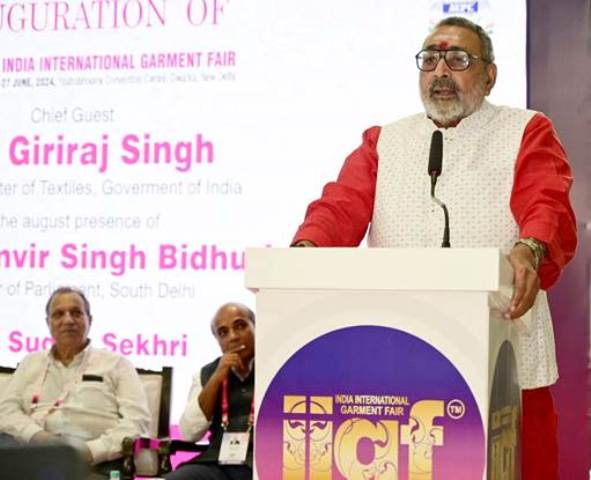Union Minister for Textiles, Shri Giriraj Singh, inaugurated the 71st edition of the India International Garment Fair (IIGF) at the Yashobhoomi Convention Centre. In his inaugural address, Shri Singh emphasized the IIGF's role as a unique marketing platform for micro, small, and medium exporters, showcasing India's latest trends and diverse offerings globally. He stressed the necessity of developing world-class manufacturing facilities to realize the Prime Minister’s vision of “Make in India” with “Zero Effect; Zero Defect” throughout the value chain.
Shri Singh advocated for adopting the 'hub and spoke' model to enhance domestic manufacturing, encouraged industry collaboration, and highlighted the importance of establishing Indian brands. He also mentioned the ministry’s plans to revive the Scheme for Integrated Textile Parks (SITP) to create internationally standardized parks.
"Today, India is one of the fastest growing economies in the world with a GDP growth rate of 7.2% and is expected to be the third largest economy by 2027-28," said Shri Singh. He noted that the convergence of a positive domestic outlook with a growth-oriented political establishment has provided a conducive ecosystem for business in India, supported by government measures to enhance infrastructure and ease of doing business.
The Indian apparel and textiles market, currently valued at USD 165 billion, aims to reach USD 350 billion. Shri Singh set a target of USD 50 billion for the apparel sector by 2030. He also highlighted the Prime Minister's roadmap to promote technical fiber and geo-textile, which offers significant growth opportunities.
Shri Singh expressed his ambition to surpass China in the textile sector and noted the increasing water and raw material costs in Bangladesh. He proposed creating small clusters for smaller players in India to boost ready-made garment (RMG) exports.
The Minister announced the expansion of the Rs 10,000 crore Production Linked Incentive (PLI) scheme to the garment sector to boost domestic manufacturing and exports. He emphasized the importance of revamping textile parks and promoting green textiles.
During the event, Shri Sudhir Sekhri, Chairman of the Apparel Export Promotion Council (AEPC), acknowledged the challenges faced by Indian apparel exports due to global headwinds but commended the industry for maintaining stability. Shri Mithileshwar Thakur, Secretary General of AEPC, highlighted the potential for Indian apparel exporters to expand their footprint in developed countries.
Knowledge sessions on topics such as navigating global trade, driving manufacturing excellence, and sustainable fashion were organized on the 25th and 26th of June. The fair, organized by the AEPC through the International Garment Fair Association (IGFA) and in association with the Clothing Manufacturers Association of India (CMAI), Garment Exporters & Manufacturers Association (GEMA), and Garment Exporters Association of Rajasthan (GEAR), showcased the collective spirit and teamwork of these associations. More than 600 buyers from 50 countries participated, and the event featured fashion shows each day, showcasing the best collections.











